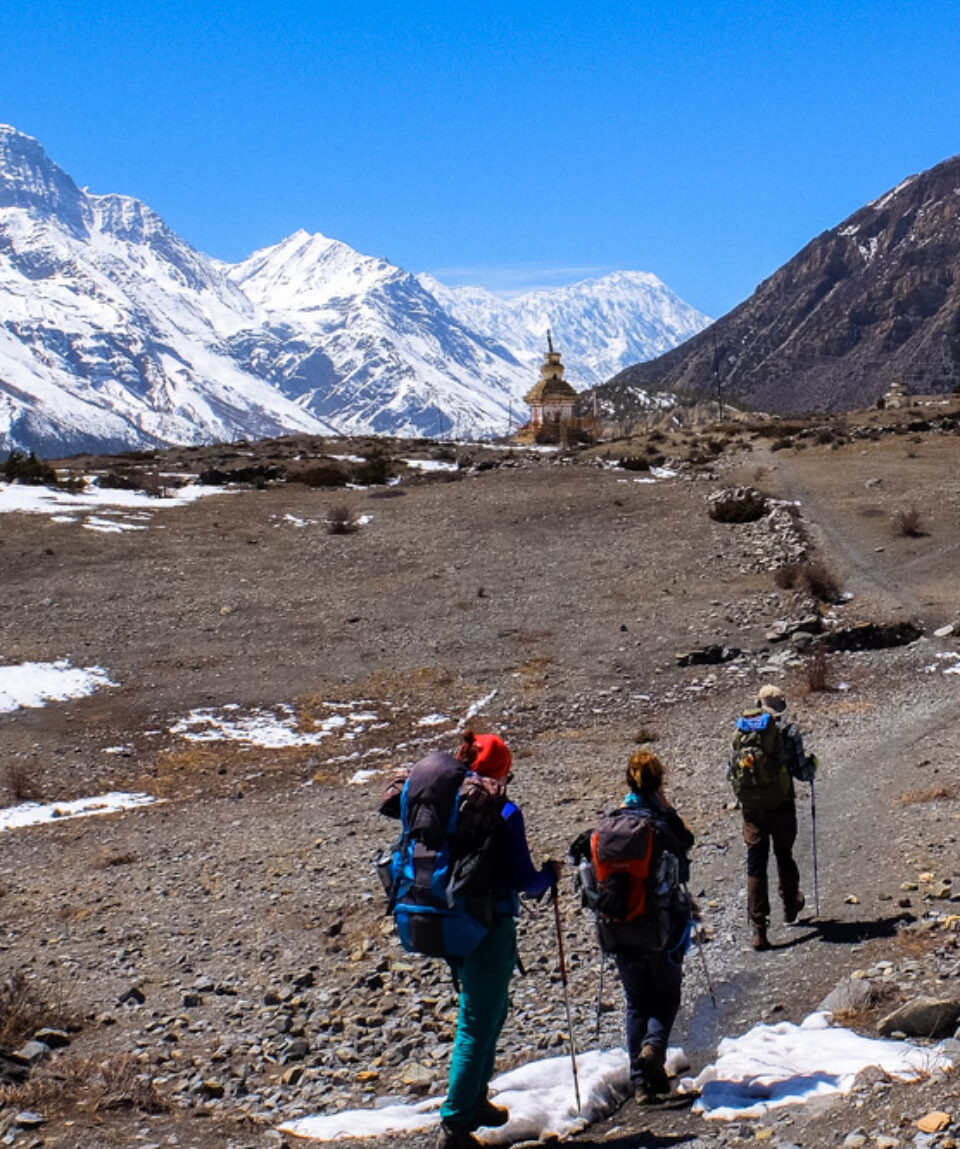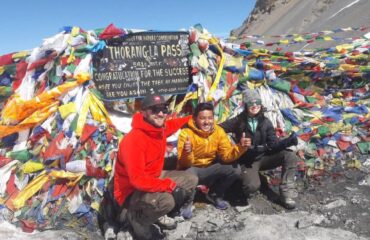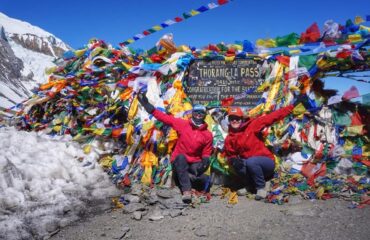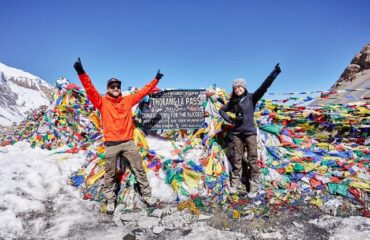Annapurna Circuit Trekking
fromTrek on the exhilarating Annapurna circuit trail, reach Thorong La pass and cross the world’s deepest Kali Gandaki gorge and experience legendary trekking routes in the world.
-
Reviews 0 Reviews0/5
-
Vacation Style Holiday Type
-
Hiking
-
-
Activity Level Strenuous
-
Group Size Medium Group
Annapurna Circuit Trekking offers an outstanding opportunity to witness the best of nature and culture around the foothills of the Annapurna Himalayas which is also popularly known as Annapurna Round Trek. Walking through amazing trekking trails while enjoying the beauty of nature, excellent views of Himalayan ranges, crossing high altitude Thorong la pass, and witnessing the cultural harmony between Hinduism and Buddhism at Muktinath are the major highlights of this trip. In general, the Annapurna Circuit trek duration ranges between 11 and 21 days depending on the route you prefer, with a daily walk of 5 to 6 hours. Although some of the route is tarred these days, it still attracts thousands of trekking enthusiasts every year.
For scenery and cultural diversity, this has long been considered the best trek in Nepal and one of the world’s classic walks. It follows the Marsyangdi Valley to the north of the main Himalayan range and crosses a 5416m pass to descend into the dramatic desert-like, Tibetan-style scenery of the upper Kali Gandaki Valley. The walk passes picturesque villages home to Gurungs, Manang is and Thakalis offers spectacular mountain views of the numerous 7000m-plus Annapurna peaks and boasts some of the best trekking lodges in Nepal.
Annapurna Circuit Trekking is a moderately challenging trip around the popular Annapurna region suitable for experienced as well as novice hikers who are passionate about walking, exploring, and adventure with a good level of physical and mental fitness level.
Flexible Itineraries
Annapurna Circuit Trekking itinerary depends on a number of factors including mode of transportation, several ending points, local people’s trails within the region, and your time availability.
The usual durations (starting and ending in Kathmandu) are from 13 to 16 days depending on what you’re planning for; we can craft a good tailored made trip based on how much time you have.
- Airport transfers and escort.
- All meals while on the trek. (Breakfast, Lunch, Dinner, Tea, Coffee, Hot beverage)
- Accommodation during your whole trip at local lodges.
- Transportation to and from Kathmandu to trek starting point as mentioned on itineraries.
- English speaking government-licensed Sherpa guide.
- Porter Service (2 trekkers = 1 porter)
- Staff cost including their (Salary, domestic airfare, equipment, food, accommodation, and insurance )
- Assistance Sherpa guides as required
- National park fees.
- All permits to enter the local municipality and Annapurna Conservation
- 3 nights accommodation at tourist standard category hotel in Kathmandu with breakfast on twin sharing basis
- 1-night accommodation in Pokhara on twin sharing basis with breakfast
- All guided sightseeing tours in Kathmandu and entry fees.
- All ground transportation on comfortable private vehicle
- All government and local taxes
- International airfares
- International Airport Departure Tax and visa fees
- Personal and Trekking Equipment
- Major meals, Lunch, and dinner during your stay in Kathmandu
- Any type of personal expenses, such as alcoholic beverages and drinks, phone, and laundry.
- Rescue & travel insurance, trip cancellation costs, accident or health emergency, evacuation, loss, theft or damage to baggage, and personal effects.
- Tips & Gratuities to porters and guides
- We strongly advise you to take out personal travel insurance.
- Day 1 Depart Home Country
- Day 2 En Route (Transit)
- Day 3 Arrival in Kathmandu (1,350m/4,429ft)
- Day 4 Drive from Kathmandu to Dharapani (1,960m/6,431ft)
- Day 5 Dharapani to Chame ( 2,710m/8,892ft) 5-6 hrs
- Day 6 Chame to Upper Pisang (3,700m/12,140ft) 5-6 hrs
- Day 7 Trek to Manang (3,519m/11,546ft) 4-6 hrs
- Day 8 Acclimatization day and excursion around manang village
- Day 9 Manang to Yak Kharka (4,110m/13,485ft) 3-4 hrs
- Day 10 Yak kharka to Thorang Phedi (4,420m/14,502ft) 3-4 hrs
- Day 11 Cross Thorang-la [5,416m/17,770ft] and trek to Muktinath [3,800m/12,478ft] 9-10 hrs
- Day 12 Muktinath to Marpha (2,670m/8,760ft): 4 – 5 hours
- Day 13 Drive to Tatopani (1200 m / 3937 ft) – 6 hrs
- Day 14 Trek to Ghorepani (2,850m/9,351ft) 4-5 hrs
- Day 15 Ghorepani to Poon Hill vist and trek to Tadapani (2,700m/8,859ft ) 6-7 hrs
- Day 16 Tadapani to Pokhara via Ghandruk ( 827m/2,713ft ) 5-6 hrs
- Day 17 Drive from Pokhara to Kathmandu (1,350m/4,429ft) 6-8 hrs
- Day 18 Transfer to airport for final departure
- Day 19 En Route Home Country
- Day 20 Arrive Home country
The main emphasis while trekking is on keeping warm and dry while still being lightweight. You should bring a rucksack or backpack for the gear required during the day. Your pack should contain items such as warm clothes, a jacket, a camera, water bottles, a personal first aid kit, and snacks. The weight limit is 5kg. A porter will carry the rest of your personal equipment packed in a duffel or kit bag. The weight limit for your duffel bag is 15 kg however it is different in the case of peak climbing and expedition.
A Note on Packing
For your international flights, we recommend that you pack all your equipment in your two duffle bags or suitcase. Do not simply pack your backpack (since the straps can be damaged by the baggage handling machines). It is important to lock these bags for their trip. Depending on the airport, you may be able to put your travel locks on after TSA has searched the bags. If not, Lock the bags with Zip Ties. If the TSA cuts off the zip-tie to search your bag, they will replace it. You will still need the travel locks to lock your bags in the hotel and during the trek. Generally, you will take one duffel on the trek , and leave one in the hotel in Kathmandu with your belongings for your time in the city. Your trek in duffel will only be accessible in the evenings (with items such as changes of clothing, sleeping bag), and your day pack will hold vitals such as water, layering, blister kit, and camera.
FOOTWEAR
- Hiking Boots with ankle support. Make sure they are comfortable and you have worn them in before arriving in Nepal.
- Camp Shoes or Tennis Shoes
- Thick, warm wool and day hiking socks
- Camp Sandle
- Gaiters (Optional )
- Plastic bag to carry spare shoe
CLOTHING
- Lightweight Trekking pants
- Synthetic T-shirts, long-sleeve shirts
- Synthetic hiking pants, Zip-off pants
- Trekking trousers
- T-shirts – Lightweight, quick-drying
- Long-sleeved shirt
- Fleece jacket with wind-Stopper (With wood)
- Down vest and/or jacket
- Rain jacket or poncho (Gore-tex or equivalent)
- Rain pants (Gore-tex or equivalent)
- Down jacket medium weight
- Fleece or wool pants
- Synthetic Underwear
- Women sports bras, synthetic(for women)
- Waterproof (preferably breathable fabric) shell pants
- Long sleeve tops or shirts (not cotton).
- Microfleece.
- Mid to heavyweight fleece or synthetic/ Primaloft
HEAD & GLOVES
- Fleece gloves.
- Warms mittens and/or gloves.
- Wool or fleece hat.
- Sun hat
- Warm hat wool or synthetic that covers your ears
- Bandana or scarf (eg. Buff Headwear).
- Head torch. Bring extra batteries.
- Sunglasses with UV Protection
ACCESSORIES
- Lightweight Sleeping bag
- Trekking poles
- Basic First Aid Kit
- Daypack (Ruck Sack): Recommended size is around 30 liters. You need to have enough space to carry water
bottles, a camera, snacks, and extra clothing. The pack should have a good waist belt. It is also a good
idea to bring a rain cover to keep the contents dry - Fleece or silk liner for your sleeping bag
- Stuff sacks for keeping your gear dry and organized (Optional )
- Thermo-rest sleeping (optional)
- Water bottles
- Small wash towel
- Sunscreen and lip salve
- Water purification tablets (Pristine, Biox Aqua or Aqua Mira).
- Favorite snack food.(Optional)
- Books and cards etc.(Optional)
- Camera with spare batteries and memory cards.(Optional)
- Insurance certificate.
- Earplugs (optional).
- Hand sanitizer
- Any personal medications
TOILETERS
- Quick-drying towel (medium-sized)
- Soap (preferably biodegradable)
- Tooth brush/paste (preferably biodegradable)
- Deodorants
- Face and body moisturizer
- Nail clippers
- A small mirror (optional)
- Tissue paper/ toilet roll
- Anti-bacterial Hand wash etc ….
Conclusion:
As the weather condition is unpredictable in the Himalayan region, you need to be prepared at all times. A day can start sunny with clear skies and later become cold and windy at the high altitudes.
Sometimes, it can rain and snow during the trekking period. You need to remember that for a successful trekking journey, your physical comfort must be the first priority.
Note:
Please note that these items listed above will vary according to the season, trek duration. Please remember that your luggage will be carried by the porter, but you need to carry a daypack on your own. We also suggest you pack only necessary items to keep the weight of your equipment to a minimum. Carrying a day pack only applies to the trekkers who take the full package with us and those who take only the guide should bring the bag big enough to carry their own stuff. If you have any questions, please do not hesitate to contact us at your convenience.
Annapurna Circuit Trekking is a moderately challenging trip around the popular Annapurna region suitable for experienced as well as novice hikers who are passionate about walking, exploring, and adventure with a good level of physical and mental fitness level.
For the Annapurna Circuit, October and November or April and May are widely considered to be the best times for trekking. The weather during these two seasons is generally clear and dry, and so it’s not too cold when heading into high altitudes.
Annapurna Circuit Trek in December is usually less crowded than any other seasons. The trekking trails are mostly empty and peaceful. The weather condition and temperature of the Annapurna region are bearable during December. The weather might be quite chilly in the higher areas









